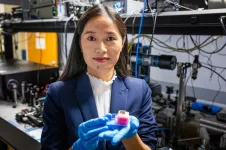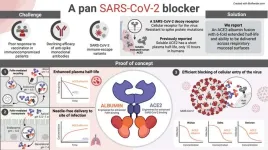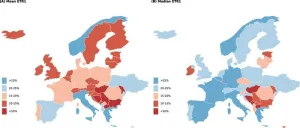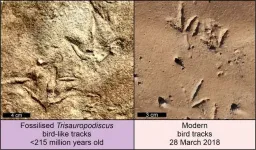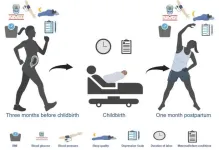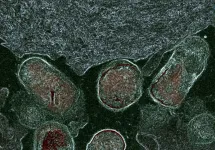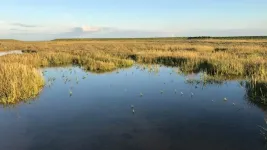(Press-News.org) Every 65 seconds, someone in the United States develops Alzheimer’s disease, a devastating form of dementia that affects 6.2 million Americans.
Though it was initially identified almost 120 years ago, Alzheimer’s disease is a progressive neurological disorder with no cure and few treatments. It starts out with minor memory loss that, over time, advances to a mental decline so severe, individuals have difficulty even swallowing.
Xiaoting Jia, associate professor in the Bradley Department of Electrical and Computer Engineering, experienced the direct, cruel impact of Alzheimer’s disease as it ravaged her grandmother’s mind, destroying memories of a long-lived and loved life.
“Alzheimer’s is a devastating problem – I’ve seen firsthand how bad it could be,” Jia said. “It’s why it concerns me as an electrical engineer. I want to build tools and try to assist neuroscientists in solving brain problems.”
It’s this personal connection that makes the high priority, short-term grant from the National Institutes of Health so poignant.
Building a new fiber
A pioneer in the neural fiber field, Jia has partnered with longtime collaborator Harald Sontheimer, professor and chair of neuroscience at the University of Virginia, and fellow brain imaging expert Song Hu, associate professor of biomedical engineering at Washington University in St. Louis, on the development of a new neural tool: a deep brain, multipurpose fiber.
Their goal? Slowing down or reversing memory loss.
Examples of previous preform pulled through Xiaoting Jia's thermal fiber drawing tower. The preform gets thinner and thinner as it's pulled, creating the tube that houses different fibers or filaments. Photo by Ben Murphy for Virginia Tech.
“What we are doing here together is creating a device with which we can visualize the build up of biomarkers that are the culprits of Alzheimer’s disease,” Sontheimer said. “Usually you can’t access or image that part of the brain, but this device will provide access to the hippocampus, home of spatial memory and retention.”
The team has one year to build a minimally invasive, long-term fiber – not much thicker than a strand of hair – to study those biomarkers, including thick protein deposits called amyloids in the hippocampus.
Current electrical and imaging tools by neuroscientists are limited in resolution, both time and spatial, such as an MRI or electroencephalogram. Some are more invasive with large electrodes with which doctors need to “fish” around in an attempt to apply electrical stimulation to the deep brain.
“A big problem in Alzheimer’s research is there are a lot of dysfunctions in the brain having to do with neurovascular changes,” Hu said, “but we don’t totally understand how those changes impact memory loss and behaviors that eventually impair their life. Conventional techniques have provided an important understanding of neurons and vasculature, but there’s a technology limitation.”
The super fiber Jia will construct stands out from other existing technologies because of the flexible polymer platform. Little to no damage of brain tissue and long-lasting potential means fewer complicated surgeries, and more time with family.
Defeating the deposits
“Amyloid deposits are the main feature for AD [Alzheimer's disease], and they begin developing years, even decades, before people show AD symptoms,” Jia said. “It’s still a mystery how the deposits even begin.”
According to Jia, there’s no confirmed causal relationship between Alzheimer's disease and the deposits – yet. However, the relationship between plaque buildup and the onset of symptoms is the guiding focus of the team’s research, with each researcher taking on a key component in the creation of this first-of-its-kind fiber:
Building on expertise highlighted in her National Science Foundation Faculty Early Career Development (CAREER) award, Jia will thermally draw a multifunctional fiber for electrical stimulation and drug delivery, leaving a hollow core.
In that core will go Hu’s dual-mode endoscope for capturing two different types of images in the brain.
Sontheimer will develop the “chronic” implantation of the combined fiber and monitor the biocompatibility.
Xiaoting Jia holds up an example of the embedded fiber the team would use in its research. Photo by Peter Means for Virginia Tech.
Target one for the team is to utilize the endoscope. It will provide images to the team for observing neuroactivity, the initial stages of amyloid deposition, and the blood flow in vessels. The team will use this data to analyze the memory loss-amyloid relationship.
Target two is sending electrical pulses – and later, anti-amyloid drugs – in the hopes of re-establishing blood flow and oxygenation to dead neurons and restoring memory.
If that sounds complex – it is. And the team only has 12 months to develop and test two prototypes.
“This is a very ambitious goal, what we’re trying to do in one year,” Jia said. “The brain is very nuanced with more than 80 billion neurons, and we’re still behind on fully understanding how the brain functions and how diseases are formed.”
Achieving its targets will enable the fiber team to seek additional multiyear funding from the National Institutes of Health. The ultimate hope? The researchers will be able to prove their technology has the possibility to improve the quality of life for the millions of Americans impacted by Alzheimer’s disease.
END
Embedding fibers to undo the tapestry of memory loss in Alzheimer's disease
2023-11-29
ELSE PRESS RELEASES FROM THIS DATE:
Novel study finds aspirin-free regimen benefits patients with LVAD
2023-11-29
The ARIES-HM3 Randomized Clinical Trial assessed the safety and efficacy of excluding aspirin from the antithrombotic regimen in patients with advanced heart failure who have undergone implantation of a fully magnetically levitated left ventricular assist device (LVAD).
“We can now safely say that not giving aspirin is not only safe from a thromboembolic risk profile but results in improved adverse event rate by a significant reduction in non-surgical bleeding which is a well-known complication related to LVAD therapy,” said Mirnela Byku, M.D., Ph.D., MBA, co-author of the study and director of the UNC Durable Mechanical ...
Your local sea snail might not make it in warmer oceans – but oysters will
2023-11-29
The frilled dog winkle may sound like a complex knot for a tie, but this local sea snail holds clues to our warmer future, including a dire outlook for species that can’t move, adapt, or acclimate as fast as their environment heats up.
Strait of Georgia hotspot
To figure out how location affects vulnerability to a changing climate, UBC zoology researchers Drs. Fiona Beaty and Chris Harley collected marine snails from the Strait of Georgia, a potential hot spot of climate risk, and the Central Coast, where waters are cooler and warming more slowly.
They monitored snails ...
600 years of tree rings reveal climate risks in California
2023-11-29
The San Joaquin Valley in California has experienced vast variability in climate extremes, with droughts and floods that were more severe and lasted longer than what has been seen in the modern record, according to a new study of 600 years of tree rings from the valley.
The researchers used the tree rings to reconstruct plausible daily records of weather and streamflow scenarios during the 600-year period.
This new approach, combining paleo information with synthetic weather generation, may help policymakers and scientists better understand – and anticipate ...
Big cities foster socioeconomic segregation; Here’s how we can fix that
2023-11-29
We tend to think of large cities as melting pots – places where people from all sorts of backgrounds can mingle and interact. But according to new research, people in big cities tend to primarily interact with other individuals in the same socioeconomic bracket, whereas people in small cities and rural areas are much more likely to have diverse interactions.
Using cellphone data, a collaboration of researchers led by Stanford University determined that most people in big cities have very few opportunities for even brief interactions with those outside their own socioeconomic status. ...
A long-acting biologic with transmucosal transport properties that arrest SARS-CoV-2 virus variants
2023-11-29
When the COVID-19 pandemic first started, no effective anti-viral drugs were available to fight the disease. However, in record time, so-called monoclonal antibodies were developed as a lifesaving treatment. Now, 3 years later, none of the approved antibodies work effectively against the new SARS-CoV-2 virus variants due to mutations that alter their spike protein.
While vaccines protect against severe disease, there is still an urgent need for effective virus-blocking agents for therapeutic or prophylactic use. This is particularly relevant for patients ...
Study reveals the real tax rate paid by multinational corporations in 47 countries
2023-11-29
Despite a similar statutory tax rate for multinational corporations (MNCs) across many countries, the effective tax rate that MNCs actually pay differs greatly — as low as 1% of gross income in Luxembourg and as high as 67% in Norway. That’s one conclusion of a study published this week in the open-access journal PLOS ONE by Javier Garcia-Bernardo of Utrecht University, the Netherlands, Petr Janský of Charles University, Czechia, and Thomas Tørsløv of Danmarks Nationalbank, Denmark. The study comes on the ...
Unknown animals were leaving bird-like footprints in Late Triassic Southern Africa
2023-11-29
Ancient animals were walking around on bird-like feet over 210 million years ago, according to a study published November 29, 2023 in the open-access journal PLOS ONE by Miengah Abrahams and Emese M. Bordy of the University of Cape Town, South Africa.
Numerous fossil sites in southern Africa preserve distinctive three-toed footprints that have been named Trisauropodiscus. For many years, researchers have debated what animals might have left these tracks, as well as precisely how many different species (technically called ichnospecies) of Trisauropodiscus there are.
In this study, the researchers reassessed the ...
Exercise may reduce postpartum depression, with moderate intensity exercises three to four times a week being especially effective, per meta-analysis
2023-11-29
Exercise may reduce postpartum depression, with moderate intensity exercises three to four times a week being especially effective, per meta-analysis
###
Article URL: https://journals.plos.org/plosone/article?id=10.1371/journal.pone.0287650
Article Title: Effectiveness of aerobic exercise in the prevention and treatment of postpartum depression: Meta-analysis and network meta-analysis
Author Countries: China
Funding: This work was financially supported by the Fundamental Research Funds for the Central Universities in China (Grant no. CUG150607). The funders did not play a role ...
Breaking down barriers: What happens when the vaginal microbiome attacks
2023-11-29
Bacterial vaginosis is a common condition in which the natural microbiome of the vagina falls out of balance, sometimes leading to complications in sexual and reproductive health. But exactly how these bacterial populations disrupt vaginal health has remained unclear.
Researchers at University of California San Diego School of Medicine have now found that in bacterial vaginosis, certain bacterial species dismantle protective molecules on the surface of the cells lining the vagina, dysregulating key processes that mediate cell turnover, death and response to surrounding bacteria.
The findings, published November 29, 2023 in Science Translational Medicine, may help explain why bacterial ...
Being prepared for storm surges on the Baltic Sea coast
2023-11-29
The record storm surge in October 2023 caused severe damage to the German Baltic coast. Effective adaptation scenarios to rising sea levels are therefore becoming increasingly urgent. In two recent studies, researchers at Kiel University have modelled both the flooding extent along the Baltic Sea coastal areas and, for the first time, two possible upgrades for current dike lines in high resolution. They modelled various storm surge and sea level rise scenarios. Their results show that, based on the current dike line, neither an increase ...
